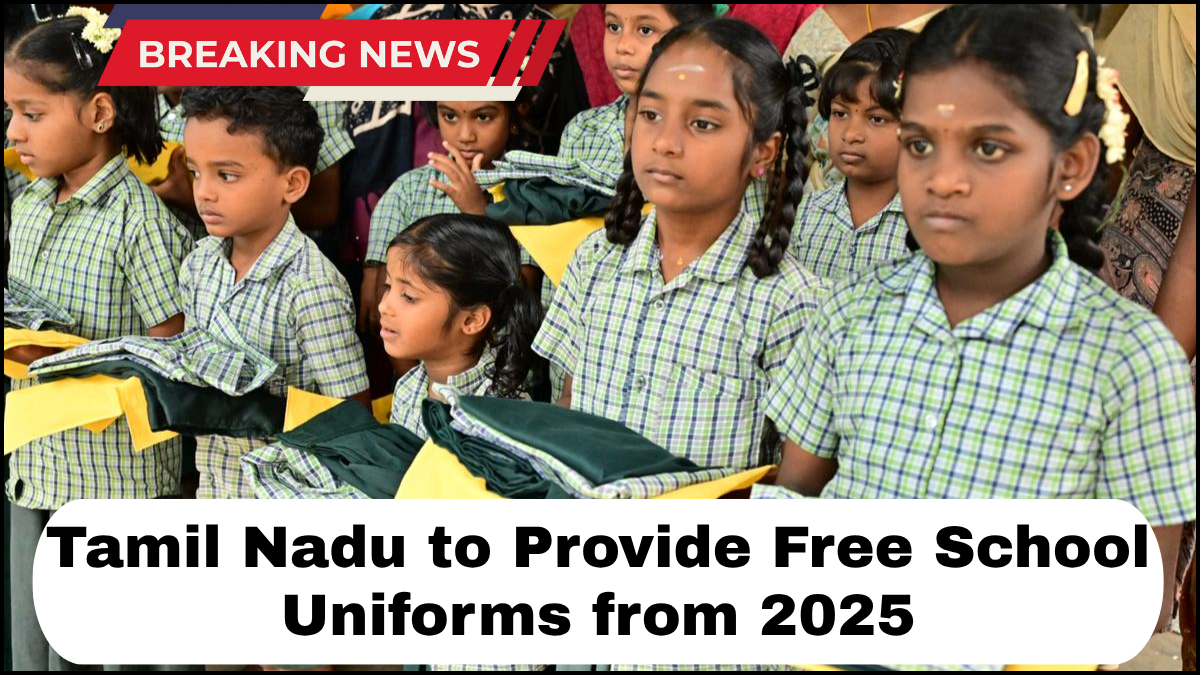In a landmark initiative aimed at promoting equality and reducing the financial burden on families, the Tamil Nadu government has announced that it will provide free school uniforms to students in government and aided schools starting in 2025. This move falls under a broader School Uniform Subsidy scheme, which seeks to ensure that all children, regardless of their economic background, have access to basic educational necessities.

A Step Toward Inclusive Education
The provision of free school uniforms is not just about clothing—it’s a significant step in encouraging inclusive education. Many families across Tamil Nadu, especially in rural and economically disadvantaged regions, struggle to afford uniforms, which can lead to irregular attendance or even dropouts.
By introducing a School Uniform Subsidy, the state government is removing a key barrier to education. When children don the same uniform, it levels the playing field and fosters a sense of belonging, dignity, and discipline among students from diverse socio-economic backgrounds.
Who Will Benefit?
The new policy will cover students from Classes 1 to 12 who are enrolled in:
-
Government schools
-
Government-aided schools
-
Panchayat union and municipal schools
Officials estimate that over 6 million students across the state will benefit from this scheme annually. The subsidy will cover the full cost of stitching and materials, including shirts, skirts, pants, salwars, and dupattas, depending on the school’s uniform design and gender-specific requirements.
Implementation and Quality Assurance
The Tamil Nadu government plans to roll out the program in a phased but time-bound manner, ensuring full implementation by the beginning of the 2025 academic year.
Key aspects of implementation include:
-
Local tailoring units will be engaged to support the stitching work, generating employment within communities.
-
Uniform quality standards will be strictly monitored through district education officers to avoid subpar materials.
-
Color, fabric type, and stitching guidelines will be standardized across districts to maintain consistency.
-
Schools will be required to take measurements and place orders well in advance to ensure timely delivery before the academic year begins.
This approach not only ensures uniform availability but also stimulates local economies by involving small-scale garment workers and tailors.
Financial Allocation and Sustainability
The scheme is projected to cost the Tamil Nadu government approximately ₹500–₹700 crore annually, depending on material costs and the number of beneficiaries. The budget will be allocated from the state education and welfare funds, with potential for central assistance under the Sarva Shiksha Abhiyan or other centrally-sponsored schemes.
To keep the initiative sustainable:
-
The government may introduce digital tracking for distribution and inventory management.
-
Community participation through School Management Committees (SMCs) will help monitor the distribution process.
Past Successes That Led to This Policy
Tamil Nadu has historically been a front-runner in educational reforms. The midday meal scheme, free textbooks, and bicycle distribution have significantly improved enrollment and retention. The School Uniform Subsidy adds another pillar to this model by addressing appearance-based inequality and financial constraints.
Expected Long-Term Impact
-
Higher Enrollment: With reduced economic burden, more parents may enroll their children in school.
-
Improved Attendance: Students are more likely to attend school consistently when they feel they belong.
-
Enhanced Focus on Learning: Uniformity removes distractions related to fashion or economic disparity.
-
Social Inclusion: The scheme fosters unity and minimizes class distinctions among students.
Frequently Asked Questions (FAQ)
Q1: Who is eligible for the free school uniforms?
All students from Classes 1 to 12 in government and government-aided schools across Tamil Nadu will be eligible under the School Uniform Subsidy scheme.
Q2: Will the uniforms be the same across all schools?
While the material and quality will be standardized, schools may retain specific designs or colors as per their existing policies.
Q3: How will the government ensure the uniforms are delivered on time?
District-level planning, local tailoring contracts, and advance measurements will help ensure timely distribution before the academic session starts.
Q4: Can private school students apply for this subsidy?
No, the scheme currently covers only government and government-aided institutions.
Q5: Is there any application process for parents or students?
No separate application is needed. The school administration will coordinate with the education department to distribute uniforms to all enrolled students.
click here to learn more